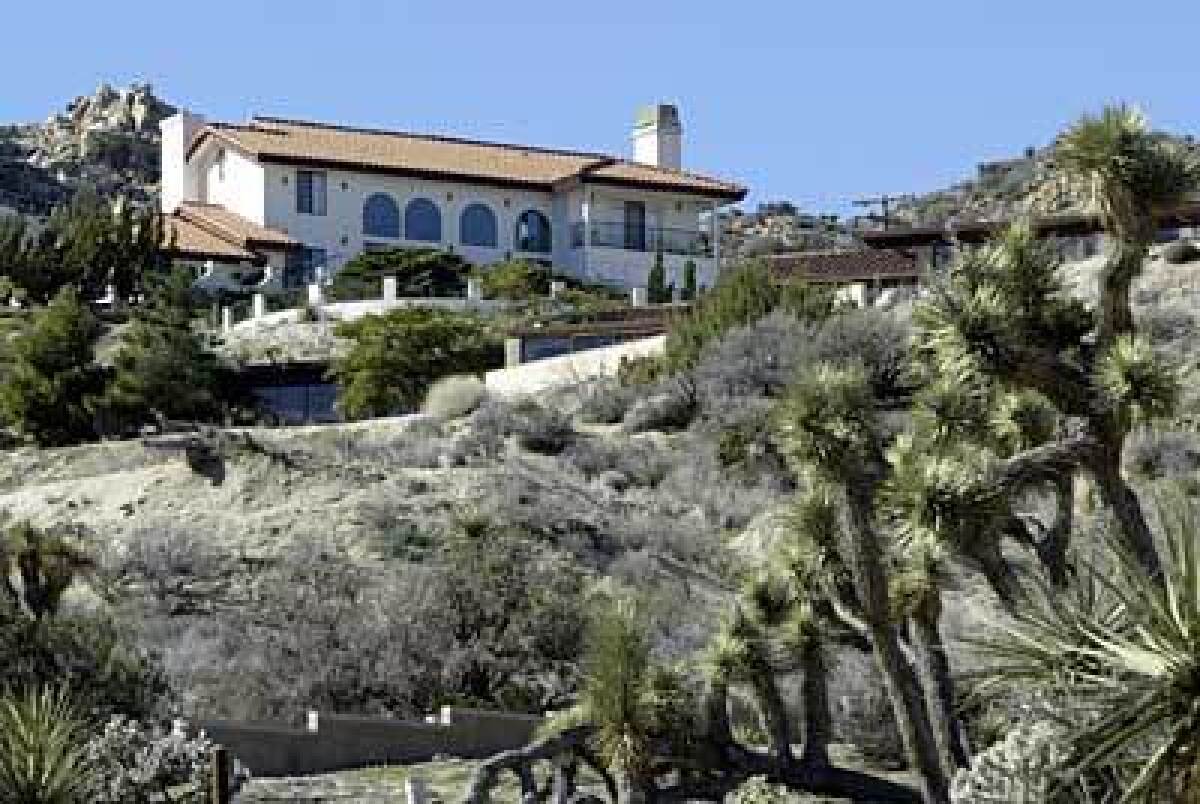Shaking the dust off its cowboy boots

- Share via
Yucca Valley may have started as a 19th century cow town and rest stop on the way from Arizona to the San Gorgonio Pass, connecting the Coachella Valley with the San Bernardino Valley, but in recent years the city has experienced growth that is changing its Western cultural identity.
Local geography
Yucca Valley is in the Little San Bernardino Mountains, above the Coachella Valley, at an elevation of about 3,200 feet. About 120 miles east of Los Angeles via Interstate 10 and California 62, Yucca Valley is in the shadow of snow-capped peaks.
Beginnings
The Serrano and Chemeheuvi Indians were the first residents of Yucca Valley. They made summer treks to the San Bernardino Mountains and to the warmer Coachella Valley in winter.Smallpox epidemics decimated the population, however, wrote May Lillian Clark and Twila G. Couzens in “Yucca Valley and Its History.”
Prospectors came looking for gold, silver and lead in the 19th century, and some ranchers began raising cattle in the high desert.
In 1878, Mark B. “Chuck” Warren came from San Bernardino to Yucca Valley. Warren dug a well at what is now the Yucca Valley Airport — important in a place thirsting for water. The watering hole was a way station for travelers, and later a stagecoach stop. It also became known as a roundup point for cowboys driving herds of cattle to summer pastures at Big Bear or to the railroad at Victorville.
In the early 1900s, the federal government gave 160-acre parcels to veterans of the Spanish-American War. They had to live on the land for three years and make some improvements. The Small Tract Act of 1938 opened up 2 1/2 - and 5-acre parcels in and around Yucca Valley. Homesteaders raised livestock and often grew crops such as alfalfa, beans and grain.
For the first part of the 20th century, Yucca Valley was known as Lone Star, named after the Lone Star Ranch. In 1946, the town forefathers purchased 3,000 acres, subdivided the land, installed water lines and called the area Yucca Village. The name didn’t quite stick. Yucca Valley was officially incorporated in 1991.
Drawing card
“We’re close to the Colorado River, to Big Bear, to Palm Springs,” said Jim Schooler, director of community services and a longtime resident. “It’s a nice location if you don’t mind driving a little bit.”Most of the area’s residents commute “down the hill” to Palm Springs, Riverside or San Bernardino, Schooler said. “There’s still a lot of open space, and most houses have about a half-acre to an acre. You can still get 2 to 5 acres easily. And for a lot of people, it’s still a bargain.”
Good news, bad news
Yucca Valley had a population of 18,700 last year, according to the California Department of Finance. The town has experienced an almost 10% growth rate since 2000, in part because of a surge in housing developments and custom-built homes.
“Our concern is to manage the growth and retain that hometown feel that everyone moved here for,” Schooler said.
Wanda Stadum, president of the Old Town Merchants Assn., said that much has changed since she moved to Yucca Valley from Long Beach in 1982. It was the clean air and starry skies that drew her to the high desert, she said, as well as the housing. The town was growing then, but with very little attention paid to county laws and zoning, Stadum said.
“The county was Big Brother, and it wasn’t even out here that much, so people got away with stuff that was substandard and not right.”
Identity shift
The Wild West legacy of Yucca Valley is celebrated during Grubstake Days, a weeklong event in May that pays homage to the area’s mining past and colorful history. Last year the town celebrated with a rodeo, Pony Express reenactment and carnival.But Stadum, like some newer arrivals, doesn’t want Yucca Valley to be known as just a cow town anymore.
“It’s not split-rail fences and wagon wheels everywhere. We’re much bigger than that,” Stadum said. “We hope to change that image. We’re really more of an eclectic place with all kinds of people.”
New businesses, such as the coffeehouse Water Canyon Coffee Co., New Age and health-food stores, are taking the places of feed and Western shops. Art festivals and events seem to dominate the community calendar.
Stock report
In mid-January, there were 146 single-family homes for sale in Yucca Valley, according to Realtor.com. The offerings ranged from a one-bedroom, one-bath, 644-square-foot home on 2 1/2 acres for $69,900 to a two-bed- room, two-bath, 1,726-square-foot home on 160 acres for $4 million.An average three-bedroom, two-bath home goes for about $170,000, said Ann McErlane, real estate broker with Glen Realty in Yucca Valley. Home prices for the area were up 25% in 2004 from 2003, according to DataQuick Information Systems.
Report card
The Morongo Unified School District’s 2004 Academic Performance Index scores are not yet available. Grade scores in 2003 ranged from 686 at Yucca Valley Elementary to 759 at Onaga Elementary, out of a possible 1,000. La Contenta Junior High School scored 652, and Yucca Valley High School scored 679.Historical values
Residential resales:Year...Median Price
1990...$70,5001995...$60,000
2000...$69,000
2003...$112,000
2004...$140,000
Sources: DataQuick Information Systems; California Department of Finance; realtor.com; Glen Realty, Yucca Valley; “Cattle Brands of the Joshua Tree National Monument Region” by Lucile Weight (1975); api.cde.ca.gov.
More to Read
Sign up for The Wild
We’ll help you find the best places to hike, bike and run, as well as the perfect silent spots for meditation and yoga.
You may occasionally receive promotional content from the Los Angeles Times.






